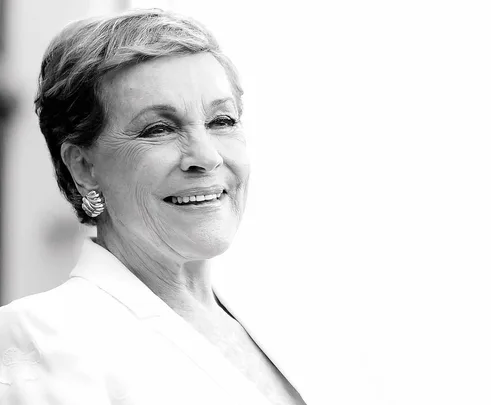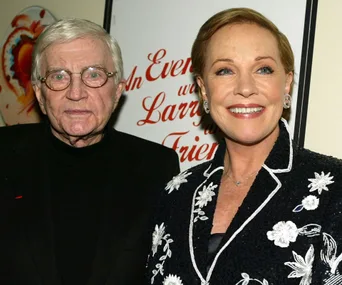When Julie Andrews received her damehood from the Queen in 2000, it felt incredibly apt. Prim, posh perfection is the pervasive image of the British-born star of stage and screen. Of course, she must be a dame!
And yet behind the polish and the innocent magic of her most famous roles – Mary Poppins and novice nun turned incomparable stepmum Maria von Trapp – is a personal life filled with struggle and fortitude, failure and passion, and plenty of heartache.
Julie was raised “on the other side of the tracks” by an alcoholic and abusive stepfather and a mum who also descended into alcoholism. Her childhood was poor and troubled, and it was young Julie’s unique talent that became the much-needed meal ticket for the whole family.

Julie (centre) on the set of The Sound of Music.
After her exceptional singing voice was discovered – literally an adult’s vocal range in a child’s chords – she was thrust into vaudeville from the age of 10, performing on stage with her parents and touring England through World War II. At 13, Julie performed at the Royal Variety Command Performance in front of King George VI and Queen Elizabeth.
At the same time, thanks to the shortcomings of her addled parents, Julie was caring for her half-brothers and by the age of 15, the whole family was relying on her pay cheque.
On the eve of her 19th birthday, Julie made her Broadway debut in The Boy Friend – “the audience danced the Charleston down the aisles as they exited the theatre,” recalls Julie. And so began a pattern in Julie’s career; with every new venture another door opened.
Julie was noticed by musical theatre geniuses Alan Jay Lerner and Frederick Loewe, who asked her to audition for the role of Eliza Doolittle in My Fair Lady. The work was gruelling, and committing to a life in New York for a two-year contract away from her family, who she felt needed her, was tough.
“I was deeply anxious about leaving my family for such an extended time. I spent the better part of the flight back to the States weeping copiously.”
But it was worth it. Even though she was passed over for the film – Audrey Hepburn landed it – Eliza proved to be Julie’s entry pass to Hollywood. After the New York run, the show played in London’s West End for a year and Julie subsequently starred opposite Richard Burton in the musical Camelot.
Towards the end of its Broadway run, Julie received a backstage visit from Walt Disney, who cast her as the nanny with a carpetbag full of tricks and a musical score that showcased her intoxicating range.
Mary Poppins was box office gold, sparking stardom on a scale Julie still wonders at. To the rest of us marvelling at her nightingale four-octave range, it seems completely appropriate.
By this time Julie had married her first love, set and costume designer Tony Walton, and together they had daughter Emma. It was Tony who designed her costumes for Mary Poppins.

Young Julie learning the piano with mother Barbara in 1947.
These early years from rags to if not riches, certainly success, were charted in Julie’s first memoir Home, published 11 years ago. What came next is the subject of her new work, Home Work.
Both books were co-written with her eldest daughter Emma, now 56 and a mum of two herself. And when I ask Emma to sum up her 84-year-old mother in one word, she immediately offers “resilience” – which is interesting because it’s the moniker Julie used earlier when I asked her to describe her own mother, Barbara Ward Wells.
Despite her shortcomings, Julie adored her mum and confesses she learned a great deal from her.
“She had a love and respect for music. She was a wonderful pianist, a very funny lady, and much more full of life than I think I ever could be… I think I’m much, much paler compared with her. In my eyes, anyway. She wasn’t a stage mum as such. She was very strict: ‘Don’t you dare get swollen heads, don’t you dare complain, you’re lucky to have what you have, and blah blah blah’ – which I thought was rather good. I still do.”

Julie with Tony Walton and Emma.
Emma describes her grandma Barbara as “a hedonist, who loved good food, music, handsome men… and booze.”
Mother and daughter are chatting together – and to me – at Julie’s house in Los Angeles.
They are known for finishing each other’s sentences, which must have been handy writing together, and as we start to talk I realise there is a solid backbone of unquestioning love and unshakeable mutual support binding Julie and Emma, which I suspect has sustained them through some very choppy waters.
In Home Work they chart the ups and significant downs of Julie’s Hollywood years, which proved revelatory for Emma and at times painful for her mum.
“Although Emma helped me with the first book, that was a part of my life when Emma hadn’t even been born. In this book, of course, she participated in some of what I was writing about so it was a very moving experience. We laughed and cried on this one, I think,” confesses Julie.
“It’s like reviewing a life all over again, and I have kept a lot of diaries, really in-depth diaries, which helped a great deal. Emma was the nuts and bolts of everything and we consulted together daily towards the end. It took about three years in all.”
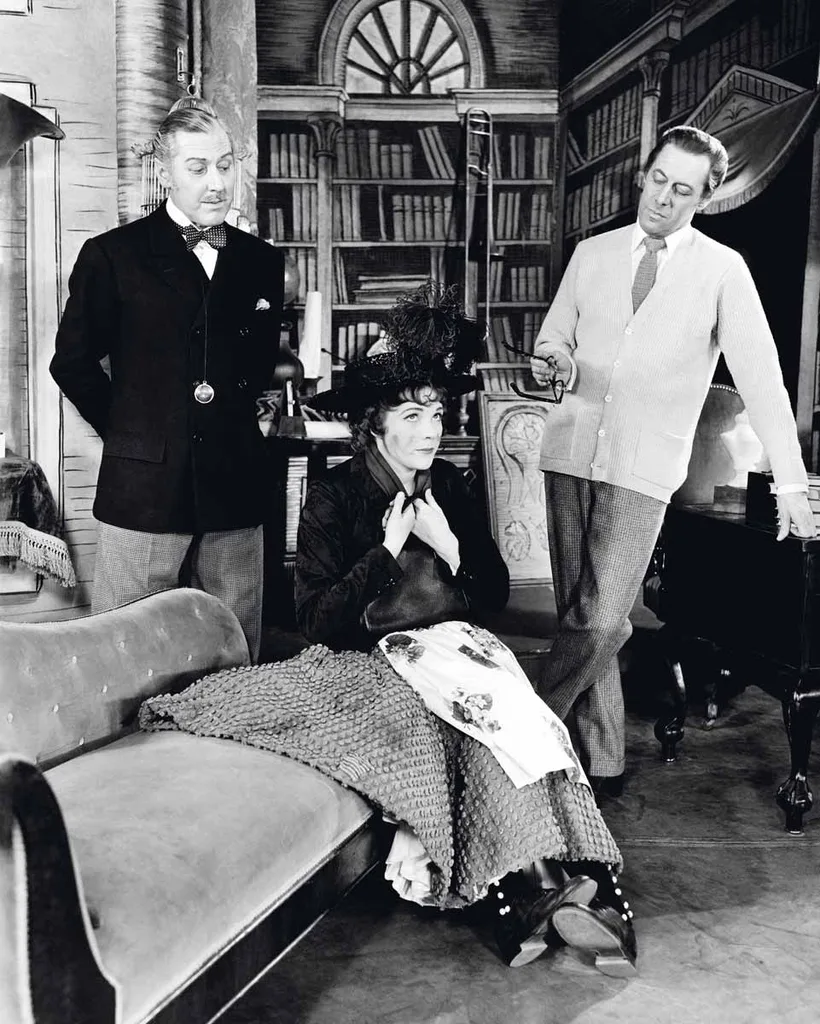
Julie with Rex Harrison and Reid Shelton in My Fair Lady.
For Emma, the experience gave her a deeper understanding of her mum.
“I was present for most of the memories in these books, but I had my own version of those memories. What I remember was being a child and thinking, ‘Mum is a grown-up and Mum has all the answers and Mum knows everything,’ because as a child that’s how you imagine your parents.
“In fact, what I discovered, which is very much what I discovered when I had my own children, is that just because you’re a parent doesn’t mean you know everything and very often you’re flying by the seat of your pants. For me it was interesting to discover how human and sometimes flummoxed or confused or innocent she was.”
In the book Julie talks in depth about her roles, how the extra sparkle of Mary Poppins and The Sound of Music was created against a backdrop of punishing hard graft. Julie was young with a lot to learn and she was determined to succeed. But there was a price.
Constant separation, living in different countries, and the pressures of both of them building their careers pulled Julie and Tony physically and emotionally apart. At one point, Julie hit a wall and simply couldn’t stop crying. She had always coped and grabbed every opening with both hands, but now she was falling apart.
Her friend, theatre director Mike Nichols, mentioned he was in psychoanalysis and suggested Julie try it. She made an appointment without telling Tony and in the book recalls the tears of that first meeting.
“I began to understand that the stress of trying to keep my family together all those years – supporting them at such a young age; my mother’s depression; my stepfather’s alcoholism; striving to hold on to the house that meant so much to us all – combined with the pressure of the war and touring all over England year after year, followed by the steep learning curve and rigorous demands of Broadway, a marriage and a child and now Hollywood… all of this had generated powerful emotions inside me, which I had buried in order to survive.”
Therapy was a revelation and helped Julie enormously. “I was in therapy for a long time,” Julie tells me. “It was a great help to me in troubled times but also in hardworking times and happy times. It became part of my life at the time, for 30 or 40 years. It became my friend.”
But Julie couldn’t save her marriage and Emma was almost five when her parents divorced.
“Tony and I had known each other since I was 12 or 13 and it was a great friendship, and it still is,” says Julie.
“That has never wavered and so even though it was very painful, the worst of it was you feel such a failure because it’s certainly nothing that one anticipates going into a marriage. I did feel I’d failed at it miserably and blamed myself for a great deal. Although I think it probably was a little bit of both [of us].”
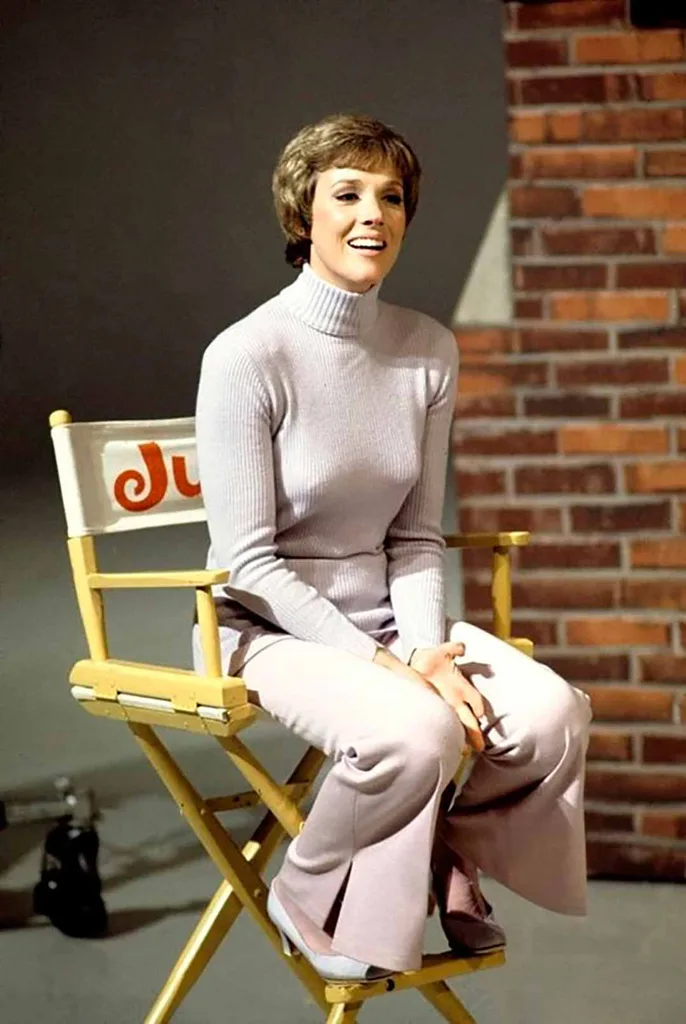
Julie on set.
Two years later Julie married charismatic Breakfast at Tiffany‘s film director Blake Edwards, although when he first proposed she wasn’t ready to commit.
“This came as a total surprise. We had only been seeing each other for a little over a year, and neither of us was yet divorced from our former spouses,” Julie writes.
When I ask Julie today how she felt when Blake proposed to her so quickly, she says she was “hesitant because he was very mercurial. I think it was about three years before we finally did tie the knot, but we bonded. I felt he was the most charismatic and interesting fellow I’d ever met, and there’s no doubt that to this day I don’t think I’ll ever find anybody quite like him. He was unbelievably terrific.”
Blake had two children of his own and I wonder if Emma recalls feeling left out when her family suddenly burgeoned.
“When Mum and Blake got together, I was pretty young. I was three or four when they met, so I actually don’t have too much memory of a life without siblings, because both my parents remarried when I was quite young and then I gained a sibling on my dad’s side and the two on my mother’s side. I always felt like we were an extended family and then, of course, my younger sisters came along when I was 10.”
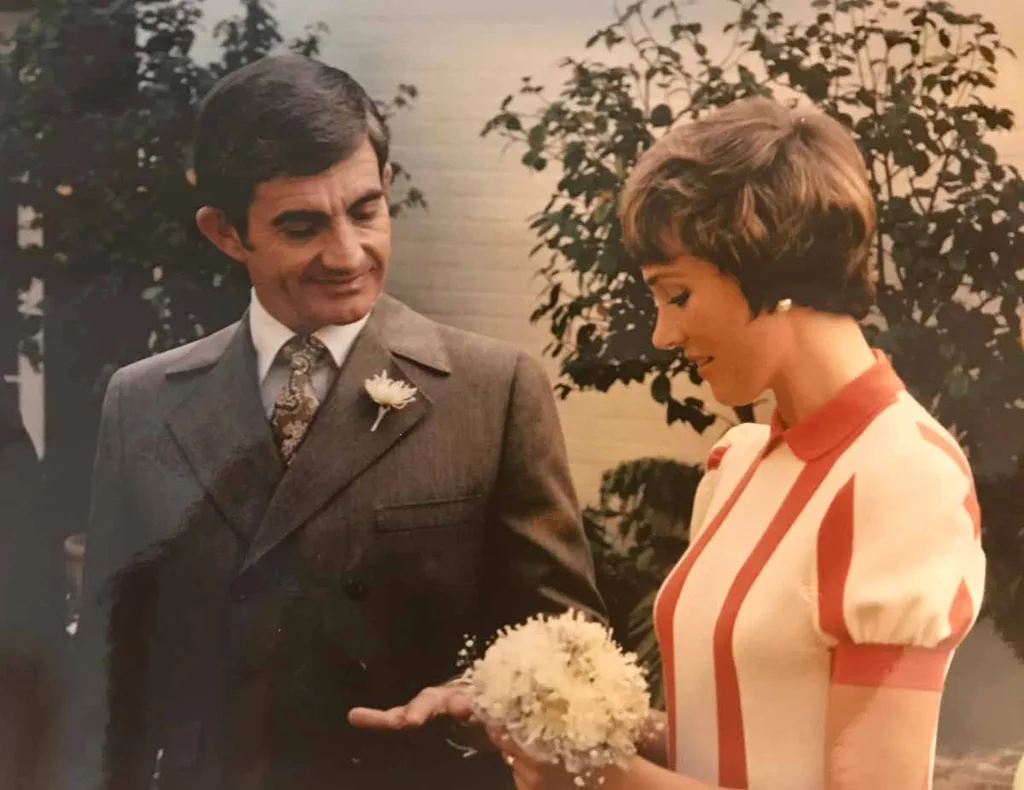
Julie marrying Blake in 1969.
Emma is talking about the two Vietnamese refugees Julie and Blake adopted. After four years of marriage Julie, who was then 38, and Blake, then 51, started to talk about having a child together, but when they had no luck conceiving decided to adopt.
They were inspired by their friends’, André Previn and his new wife Mia Farrow’s, adoption of a daughter from Vietnam. After talking to Mia, Julie wrote off to their contact in Saigon and was delighted when she and Blake were accepted as adoptive parents. The result was baby Amy, and just over a year later a second Vietnamese refugee, Joanna, joined them.
“When we hoped to adopt, the first and foremost thing we did, of course, was to get permission from the kids,” says Julie. “Emma especially was very, very generous about it: ‘if that’s what you want, Mum, go ahead.’
“Then when the second one – Joanna – came along, I remember Emma said to me again, ‘Okay, if that’s what you really want, but don’t expect me to babysit,'” says Julie with a giggle.

Julie with her children and stepchildren (top row, from left) Amy, Geoff, Emma (and seated) Joanna and Jennifer.
Family is everything to Julie, who is now a grandmother to 10, but it hasn’t been easy. Much of the book is about Blake – the good times and the bad. Blake, who died in 2010 from pneumonia, suffered from mental health issues including hypochondria and depression, which at times led to suicidal thoughts.
“He had a very addictive personality but he fought it for a long time… I think eventually it did get hold of him,” Julie tells me.
Writing Home Work has allowed her to stand back. “One was so busy getting on with life and coping, being a mother, working and holding us all together.
I guess I have reviewed it again and in re-reviewing, it was painful. I don’t know if I learned anything more but I certainly had great compassion for all of it. Blake was tortured and tormented by it, as a lot of us were – it’s not easy when you’re dealing with depression.”
Emma agrees. “There were difficult times, when he was in a darker place, and I think all the family was aware and worked hard to try to understand it,” she explains.

Home Work: A Memoir of my Hollywood Years by Julie Andrews with Emma Walton Hamilton, published by Hachette, is on sale now.
“Along with that, of course, came the tremendous highs which were creative moments and really funny moments and heartwarming moments, so it was a pattern in our lives,” adds Julie.
“He was often the first to admit it; the first to cop to his fallibility,” continues Emma. “He would sit us down and say, I’m really struggling right now, I need your help.”
The book ends in the late 80s, with Blake and Julie heading back to Broadway to prepare their hit film Victor/Victoria for the stage. Not in the book is probably the most cataclysmic moment of Julie’s life when in 1997, following surgery to remove noncancerous nodules on her vocal chords, she awoke to discover her voice, that glorious soprano that had delighted so many, was gone.
“It changed my life. What can I tell you?” says Julie with a deep sigh.
“I know it required on my part a period of mourning and then literally a change. I knew I had to get on with life or just fall down completely, and so I did embrace happily all the new aspects of life that life had to offer, and l began writing with Emma at that point and it was a saviour… I certainly miss singing, dreadfully, but it is the way it is. I think probably largely thanks to my mum I just got on with it.”

Julie and eldest daughter Emma Walton Hamilton, pictured together in 2011.
When I ask Emma how Julie coped, she says simply, “She is the most resilient soul I know.”
“Thank you, darling,” replies Julie.
“You are! And that’s not just limited to how you overcame the loss of your voice. It’s how you’ve dealt with everything in your life.
All the challenges and bumps and hurdles along the way, from your childhood until today.
“Was I worried? Of course. Was I sad and did I share her grief at the loss of that voice? Absolutely. But I’m also profoundly grateful that it exists on the record, in so many ways. We can still hear it and still listen to it and what we focus on is finding new creative outlets.”
The next creative outlet, I suspect, will be a third volume of her mum’s memoir. Watch this space.
